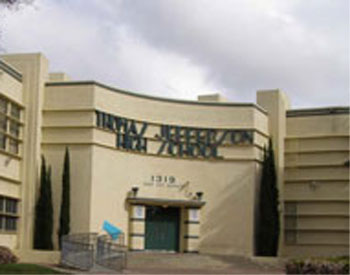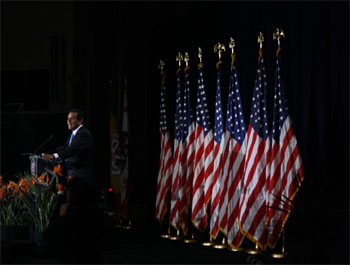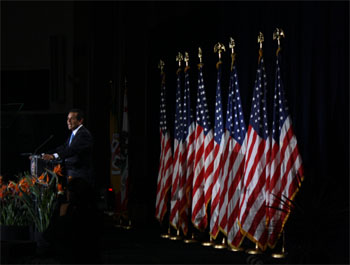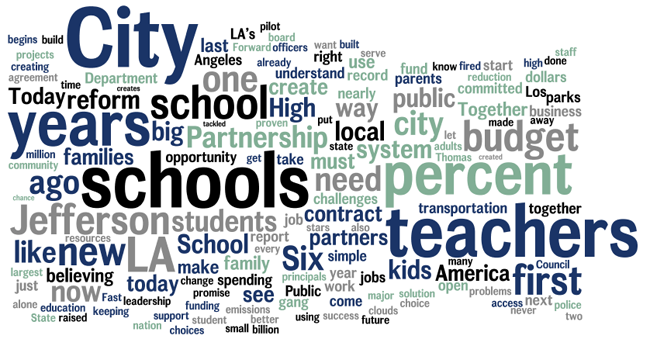The South Los Angeles Power Coaltion released their response to Mayor Villaraigosa’s address, citing specific instances where South LA is missing out on the improvements he listed.
A People’s View of the City
As the Mayor of Los Angeles delivered his annual “State of the City” speech touting various improvements in recruiting new businesses, improving test scores and expanding rail projects, residents in an area commonly known as South Los Angeles remain stuck in an alternative universe.
While the Mayor spoke passionately about Google and a handful of other corporations moving into the city, thousands of South Los Angeles renters and homeowners are at risk of losing their housing because they don’t earn enough or can’t find work. Just a few months ago, activists had to go to the streets to save the home of Faith Parker, a 79 year old retired school teacher, who was facing foreclosure as a direct result of the rising cost of living in the city of Angels. As a number of corporations – lured by the promise of tax breaks and a business-friendly government – move into Los Angeles, low-income residents in neighborhoods like Jefferson Park, Pico Union and King Estates are facing eviction from their homes because the University of Southern California (USC) and the new football stadium needs land to entertain and house wealthier individuals.
While the Mayor spoke proudly about the number of schools within LAUSD that met minimum state standards, thousands of South Los Angeles students, parents and teachers continue to be exposed to deteriorating classroom conditions. Last year, children at the newly-opened Barack Obama Preparatory Academy in Chesterfield Square were forced to go to class without textbooks and other basic necessities for learning. While test scores for some increased, African American students in LAUSD were being disproportionately suspended at a rate 3 times their population. Latino and African American students were being served by the District so poorly that the Federal Government initiated an investigation, which led to the development of an exhaustive list of corrective actions. Recent proposals like reducing the importance of homework and making D grades passing clearly shows that leaders within LAUSD are finding little solace in test score increases.
While the Mayor spoke on the urgent need to pass another tax increase to fund mass transit, South Los Angeles residents continue to suffer the negative impacts of past projects like the Blue and Expo Line. There have been disruptions in traffic patterns, accidents and yes, even deaths. In spite of his understanding of this history, the Mayor, who controls multiple votes on the MTA Board, practically ignored the pleas of hundreds of South Los Angeles residents and leaders who packed a public meeting to demand that the coming Crenshaw-LAX Line stop at Leimert Park and go underground in the Crenshaw corridor. Despite the enormous show of unity among civil rights activists, elected officials and other stakeholders, the Mayor and his supporters on the board simply voted no. As a result, South Los Angeles residents, even those in middle-class communities like Baldwin Hills will be subjected to years of travel detours, a train going dangerously fast down a busy corridor and worst, very few jobs and business opportunities for the people from the area.
The State of the City is, and has always depended upon where you live, work, attend school and shop. For the millions of residents who call South Los Angeles home, the City presents a future without a clear path to significant improvements and prosperity. Our leaders are currently divided and fighting among each other over ideas and influence. Many of our great advocacy and service organizations are struggling to keep their doors open. If we want good schools, affordable housing, quality jobs and other benefits of a free and humane society, it would appear that the regular, everyday people of South Los Angeles will have to once again rise up and fight for it. This fight will require nearly every man, woman and child in the region to make the conscious decision to take part in this movement by supporting courageous organizations who genuinely fight on behalf of the people, voting for candidates and policies that improve the quality of life (instead of relying on big-name endorsements) and organizing consistently to force elected officials to serve the needs of the community. The words spoken by the Mayor in the State of the City were indeed true. I agree with him that “we can do anything we put our minds to, and we know what we need to do.” Unfortunately, the optimism contained within the Mayor’s State of the City address does not accurately express the complete reality of those who live on both sides of the 110 freeway.
In Solidarity,
Coordinating Committee
2nd Annual South Los Angeles People’s Convention
Join Us May 12, 2012 from 8am-4pm
Maya Angelou Community School – 300 E. 53rd Street Los Angeles, CA
www.southlapower.org









 Los Angeles Mayor Antonio Villaraigosa spent most of his recent “State of the City” speech addressing education reform. Villaraigosa proposed getting rid of the “first in, last out” system, which refers to the order in which teachers are hired and eventually laid off or fired.
Los Angeles Mayor Antonio Villaraigosa spent most of his recent “State of the City” speech addressing education reform. Villaraigosa proposed getting rid of the “first in, last out” system, which refers to the order in which teachers are hired and eventually laid off or fired. Mayor Antonio Villaraigosa issued his sixth State of the City Address from a podium at Jefferson High School in South Los Angeles Wednesday.
Mayor Antonio Villaraigosa issued his sixth State of the City Address from a podium at Jefferson High School in South Los Angeles Wednesday. Los Angeles Mayor Antonio Villaraigosa promised to focus on education reform at the annual State of the City address on Wednesday.
Los Angeles Mayor Antonio Villaraigosa promised to focus on education reform at the annual State of the City address on Wednesday. 





